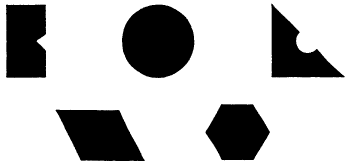
In this laboratory experiment students will gain practical experience in "observing" objects that cannot be seen. Employing the principles behind actual accelerator experiments, students will attempt to describe accurately the characteristics of these unseen objects in the same manner in which particle physicists approach the study of unknown particles. They are challenged to identity the shape of an object hidden underneath a wooden board by rolling "projectiles" (marbles) at this object and observing the deflected paths of the marbles. (To determine finer details, the activity can be repeated with smaller projectiles.)
The activity is designed to help students:
This exercise employs principles explored by the work of pioneer physicist Ernest Rutherford (1871-1937), among others; it is analogous to accelerator experiments in that it uses the results of collisions to make inferences about unseen objects.
Materials required (for five teams of students):

Place one shape under each wooden board on individual experiment tables so that they are not visible to the students.
Have the students divide into five teams to complete this experiment. Allow the teams five minutes to identify a shape. You could then have each team move on to another experiment table, to repeat the activity with a second shape.
1. Yes. As students become proficient at using marbles to identify the shapes, they can also determine the approximate size of each object.
2. Smaller projectiles can be used to check for small details, such as notches.
3. The conclusions can be checked by performing repeated trials and comparing results with those of other groups; both steps are important in real experiments.
1. Have a group of students research and report on the history of the Geiger-Marsden-Rutherford experiments that led to the idea of the nucleus in the early 1900s.
2. A second group can research the 1990 Nobel Prize-winning work of Kendall-Friedman-Taylor that verified the quark structure of protons and neutrons.
3. Many particle physics experiments involve inelastic collisions where the outgoing objects are not the same as the initial colliding objects. To simulate inelastic collisions, repeat the experiment using a cluster of three or four magnetic marbles in place of the hidden shape. Use either ordinary or magnetic marbles as projectiles. Have students discuss what they can find out about the hidden target in this case.